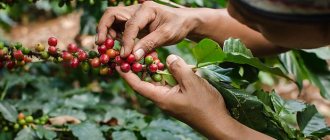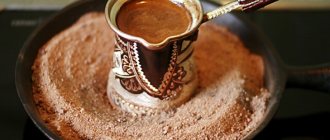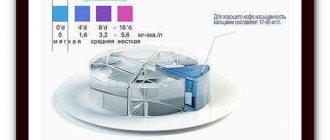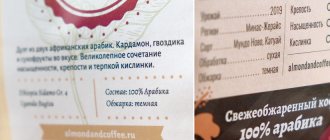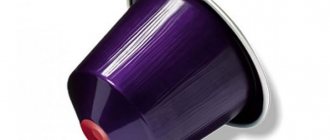Name
Many small producers name their coffees after the farm or village where the coffee is grown. If you see “finca” or “estate” on a pack of coffee, it means the coffee comes directly from a specific location with a very high degree of traceability. Also, the name can be assigned to the next, larger link in the chain. This could be a cooperative that blends, processes and packages coffee from nearby farms and villages. For example Cenfrocafe in Peru. Or the place where the coffee is transported for processing after harvesting - for example, Kigeyo in Rwanda. Less commonly, coffee may be named after the roaster in which it was roasted before packaging.
Disadvantages of instant coffee
- The main disadvantage is that the aroma is much weaker than the natural one. Manufacturers of expensive coffee brands combat this with artificial or natural coffee oils that they add to the product.
- The taste of instant coffee is quite different from natural coffee, especially cheap varieties.
- In instant coffee, the caffeine content as a percentage is lower than in natural coffee and the bitter taste component is more noticeable.
- To produce instant coffee, the lowest quality coffee beans are usually used (the best beans are saved for sale). Also, during the production process, unwanted sediment remaining after harvesting is sometimes used.
Geographical location / Region
Coffee, like wine, is a territorial drink. In other words, the environmental conditions (temperature, humidity, soil acidity) where coffee is grown affect the taste. As a result, coffee grown in different regions differs in taste. For example, Yirgacheffe in Ethiopia produces a slightly sour, light coffee with powerful floral aromas. Tarrazu in Costa Rica produces sweet coffee with a harmonious, complete taste. Brazilian coffee typically has low acidity and a noticeable nutty aroma.
GOST natural green coffee
If coffee enters our country in its original form, that is, in the form of unroasted beans, then a set of standards of 11 items applies to it. They determine what the standard green coffee should be, as well as what methods and tests can be used to determine the characteristics of natural unroasted beans.
We found GOST R 51450-99 particularly interesting. It includes a list of defects in green coffee beans. According to this standard, defects in green grains are divided into “natural” - those that arose during the growth of the grain - and “man-made”, which appeared due to violation of the rules of processing and transportation.
Defects during cultivation
- Complete or partial blackening of grain. Such a deficiency will give an unpleasant and sharp aftertaste in the finished drink.
- Brown spots or completely brown unroasted beans will also make your coffee taste rougher and harsher.
- Amber grain. A yellowish color and transparency indicate a lack of acidity. The finished drink will be uninteresting and bitter.
- Wrong shape. Such grains are roasted poorly and unevenly, and lack some of the aroma and depth of taste.
Defects in collection and processing
- Unripe grain. It roasts unevenly, giving the drink excessive bitterness and an astringent taste.
- Waxy. The effect on the drink can be the most unpredictable, it changes the taste from fruity to sharp and bitter.
- A grain with a reddish shell is not such a terrible defect. It has a minimal effect on taste and may not show itself in the bouquet at all.
- Damaged, broken grains can greatly affect the finished drink, imparting a bark or even moldy taste.
- Having a reddish-brown color inside. Signal of excessive fermentation. May give your coffee a potato or onion flavor.
- Spotted, wrinkled or retained parchment shell grains coarse and worsen the taste of the drink.
- Spongy - has a whitish color, is missing parts, the drink will have a woody taste.
Process
This category is quite important for understanding what kind of coffee you will encounter in a given package. Processing is what happens to coffee between the harvesting of the ripe coffee cherries and the packaging of the dry coffee beans. There are four main ways to process coffee harvest:
- Wet processing / Washed Process (Parchment-Dried)
- Natural Drying / Natural Process (Cherry-Dried)
- Honey Process (Mucilage-Dried)
- Wet-Hulled (Seed-Dried)
Each of these methods has a huge impact on the taste of the coffee. In countries such as Colombia, Guatemala and Kenya, coffee is predominantly processed using the wet method. In this process, the skin of the fruit is removed and the coffee is fermented and washed. This treatment produces a pure coffee taste with greater sweetness and aroma.
Natural drying is common in places without access to much water, such as Yemen and Western Ethiopia, or in places where coffee is grown on a large scale, such as Brazil. Using this method, the coffee is dried with the casing on, resulting in the beans acquiring berry aromas.
Honey processing is a mix of the first two options - coffee beans are husked from the fruit, but the remaining layer of sticky coffee juice (so-called coffee honey) is not washed off, and the beans are dried along with it. This type of coffee is common in Costa Rica, El Salvador, and Panama.
The wet peeling method is mainly practiced in Indonesia.
Coffee packaging: why is it so important to pay attention to it?
The production and sale of coffee is a very profitable business, because according to the results of 2021, Russians consume approximately 180 thousand tons of coffee drinks and now this is more than the amount of tea!
But coffee is a rather capricious product, and in order to promote your brand in an abundant market, you need to have impeccable quality. And in this sense, coffee is completely unique, because its quality often depends not on the raw materials, but on the packaging for it! The fact is that coffee beans release large amounts of carbon dioxide after roasting. You can give them time to rest, lie in the open air so that the gas evaporates - but then along with it the coffee will lose useful compounds, aroma, and taste. In addition, such “airing” cannot be carried out for longer than 1-2 hours, because the essential oils for which we value coffee so much evaporate at a tremendous speed: the beans can lose up to 40-60% per day. The release of gas also affects ground grains. In order to deliver freshly roasted, unaerated coffee to the consumer and at the same time remove the sourness from the gas, it is packaged in bags with a degassing valve. Such a hole releases carbon dioxide, but does not let outside air in to avoid oxidation.
In addition to oxygen, the enemies of this product are also humidity and proximity to other foods with a strong smell. All this irrevocably spoils the taste, making it bitter and unsaturated. Therefore, packaging must have specific features that can prevent contact with air, moisture and other products.
Variety
Like grapes, apples and almost any other agricultural product, the type of coffee bean has a big impact on the taste. Just as Riesling is different from Chardonnay, Bourbon coffee is very different from Geisha, even if they were grown on the same farm. The main thing is not to confuse the variety and the type (Species) - for example, Arabica is a type of coffee that can contain hundreds of different varieties. And this variety greatly affects the taste of coffee. Sweet and heavy Typica, bright and sour Caturra, or delicate and floral Geisha - the variety of coffee varieties offers a large number of different tastes.
Price
Natural factory instant coffee costs from 75-80 rubles to 400 rubles per 50 grams. A cheaper product is most likely a mixture with foreign substances.
Instant coffee Moscow coffee shop on shares "Arabica", glass, 95 g 221 rub.
Instant coffee Ambassador “Platinum”, 95 g 230 rub.
Instant coffee Ambassador “Platinum”, 190 g 370 rub.
Ground coffee in instant Nescafe “Gold”, 750 g 993 rub.
Coffee Jockey “Favorite”, instant, 36 g 66 rub.
Instant coffee D'Arte “Original”, 100 g 349 rub.
Instant coffee Fresco Arabica Blend, sublimated, 100 g -50%
210 rub. 420 rub.
Instant coffee 3 in 1 Nescafe “Classic Cappuccino”, 20 bags 297 rub.
High-quality instant coffee at TEA.RU
Growing Height/Elevation
Very few coffee consumers are interested in the altitude at which the coffee was grown. For the American market, this information is generally of little use, because most manufacturers indicate the altitude in meters (try saying right away - how much is 4000 feet above sea level?) But for coffee professionals, it is important to know the altitude. As a rule, the higher the plantation is located, the higher the quality of the coffee, and so on as long as the plant is able to survive. Coffee trees grown at altitude have a higher concentration of sugars and acids, resulting in a sweeter, more complex aroma in the cup. Low-rising coffees tend to have lower acidity, so if you're trying to avoid sourness in your coffee, knowing the altitude can be helpful.
GOST coffee beans and ground
The system of state standards for various types of products, including coffee, determines how well the qualities of a particular product comply with established standards.
Coffee is subject to a whole set of standards. Green, roasted, and instant coffee are regulated separately.
The current standard for roasted coffee came into force on January 1, 2016. The quality of ground and roasted grains is determined by GOST 32775-2014.
This standard is not only domestic, but also interstate and is valid simultaneously throughout the entire territory of the CIS countries.
The current standard excludes some provisions of previous GOSTs. For example, coffee beans are no longer divided into varieties. In previous GOSTs, bean coffee was divided into premium, highest, first and second grades. All coffee undergoes a series of standard tests that determine compliance with the standard.
Why are we interested in this dry official document?
It introduces the basic requirements for natural coffee, methods for determining the taste and aroma of the dry product and the finished drink. All this allows us to evaluate the quality of coffee sold in our stores. Well, or at least compare it with a reference sample.
So, what basic requirements should coffee meet according to GOST?
Physical and chemical parameters
- The moisture content of the grains or powder should not exceed 5.5%.
- The caffeine content in coffee cannot be less than 0.7%.
- Decaffeinated coffee allows caffeine content, but it should not exceed 0.3%. By the way, this confirms the thesis that even the most decaffeinated drink still contains a residual dose of caffeine.
- The amount of debris should not exceed 6%.
- The content of substances that are responsible for the aroma and taste of coffee should be between 20 and 35%
Ground coffee
The requirements for ground coffee are determined by the same GOST 32775-2014
Its organoleptic standards coincide with those of grain, but there are also special requirements for grinding.
- The mass of particles that do not pass through a sieve with 1 mm holes should not exceed 20% of the total mass. That is, ground coffee has a grind that is defined as reduced medium or fine.
Package
GOST recommends packaging roasted coffee in the following consumer packaging:
- glass and iron jars;
- paper and cardboard bags;
- polymer packaging.
How is coffee compliance determined?
To do this, there is a set of analytical methods, each of which is regulated by its own standards.
For example, moisture content is determined in a laboratory and is regulated by GOST ISO 11817-2014. GOST ISO is an international standard that is adopted as a national one.
The caffeine content is determined by a special analysis, the methodology of which is regulated by a separate standard GOST ISO 4052-2013.
The easiest way is to determine the organoleptic standards of a batch of coffee, that is, taste, aroma, richness. This process is regulated by GOST 34116-2017. It will come into force on July 1, 2021. The procedure looks simple and even pleasant.
Coffee beans are ground, and ground coffee is taken in its original form. The product is brewed with hot water in a proportion of 7 g per 100 ml of water, and then cooled to a temperature of 55 degrees. After this, the taste of the coffee is determined. If the coffee is intended for a specific preparation method, for example, in a coffee machine, then it is prepared in the specified way, and only then is it judged.
How to spot fake quality marks?
1 STEP.
Manufacturer, place of packaging
We are talking about hand-roasted coffee beans from the French coffee brand Broceliande (https://www.torrefaction.com/). Its environmental friendliness is confirmed by certificates, and its affordable price from 2 to 4 euros makes it even more attractive for purchase.
First of all, on the Russian version of coffee, our attention was attracted by the “Eurolist” sign (a sign of the European certification system for organic products). For its legal placement, the product must be packaged in the country of production - France. In our case, Russian-language letters, the absence of a sticker for imported products, as well as information from the declaration of conformity (we will discuss all this below) give us a clear idea that this is not France! This means that coffee cannot be called organic, and most likely we are dealing with greenwashing!
But that’s not all! According to international rules, in addition to the official logo, the sign must contain the country code, the organic production method, the code of the regulatory authority, and the origin of the raw materials.

